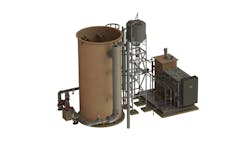About the author: Miguel Arias, Ph.D., P.E., is project manager/water treatment specialist for Orica Watercare. Arias can be reached at [email protected] or 303.268.5074.
The town of Hudson Bay, with a population of 1,500 people, is located in the Red Deer Valley, between the Porcupine and Pasquia Hills in northeast Saskatchewan, Canada. It is widely known for its forestry, agriculture and wildlife.
Like many rural communities in the province, Hudson Bay is faced with treating a challenging potable water source. Its raw water is high in dissolved organic carbon (DOC), which can vary by 4 mg/L throughout the year. DOC is a known precursor to the formation of halogenated organic disinfection byproducts (DBPs) such as trihalomethanes.
Due to the size of the population, staffing at the water treatment plant is limited to two full-time operators plus manual help, if required. Staff size dictates that water treatment unit processes must run efficiently due to an upper boundary on time that can be dedicated to successful operation. Prior to the installation of the Magnetic Ion Exchange (MIEX) pretreatment process, the main unit operation was a coagulation and filtration skid with permanganate dosed in the raw water and chlorination after filtration.
DOC Removal
The raw water source for the treatment plant is a reservoir fed by the Fir River. Historically, the influent river raw water quality varies dramatically on a seasonal basis; therefore, it is difficult to optimize chemical dosing to match changing raw water conditions.
Operating a MIEX pretreatment system prior to the existing water treatment plant allows for a muted influent DOC response to increasing raw water DOC. The raw water DOC varied from 7.7 mg/L to 11.8 mg/L, with a standard deviation of 1.4 mg/L over the course of 2012.
With the pretreatment system continuously operating, the effluent DOC averaged 2.8 mg/L with a standard deviation of 0.5 mg/L, for an average removal of 69% compared with the raw water. The decrease in standard deviation from 1.4 to 0.5 mg/L limits the variability of the raw water quality, simplifying downstream rapid mix-coagulation-flocculation treatment processes.
Prior to installation of the pretreatment system, an increase in DOC would require plant staff to rapidly optimize coagulant and chlorination doses to enhance DOC removal and maintain disinfection residuals. Since the installation of the system, the excess capacity on the MIEX resin has allowed for simpler plant operation because a large percentage of DOC has been removed prior to coagulation, and spikes in DOC have been attenuated. Therefore, coagulation can be optimized on turbidity removal, a measurement instantaneously available by analyzing floc settling characteristics and effluent turbidities.
Additional Benefits
DOC in potable water sources can react with chlorine to form DBPs. The total trihalomethane (TTHM) regulatory limit is 100 μg/L in Canada and 80 μg/L in the U.S.
The town of Hudson Bay had consistently exceeded regulatory limits for TTHM formation prior to the commissioning of the new pretreatment system in January 2012. TTHM concentrations averaged 238 μg/L for 2010 and 2011. Since the new system came online, TTHM measurements have averaged 44 μg/L. The maximum distribution system TTHM measured 60 μg/L during 2012 operations, below both Canadian and U.S. Environmental Protection Agency standards.
Chemical savings also are a direct effect of reducing the DOC at the plant headworks, where downstream reductions in chlorine and coagulant doses are realized.
The average pre-installation coagulant and chlorine doses in 2010 and 2011 were 31 mg/L and 5.3 mg/L, respectively. These doses were reduced after system commissioning by 41% for coagulant and 63% for chlorine, to yield average doses of 18 mg/L for the former and 2 mg/L for the latter, analyzing 2012 in its entirety.
The installation of the MIEX pretreatment system in Hudson Bay has yielded several benefits, all stemming from DOC removal at the plant headworks. The influent raw water quality has become increasingly predictable for a river-influenced source; therefore, the need to make significant adjustments to chlorine and coagulant doses has decreased. The chemical use has both lowered and become more predictable, allowing for decreased frequency of chemical deliveries and aiding plant staff in planning chemical storage.
Ultimately, of all the benefits that were realized, the most important is the quality of the water delivered to customers. Water that is below regulatory limits for DBPs and that tastes good (because of low DOC) allows the citizens of the small community to reap benefits normally reserved for larger treatment facilities. Currently, the MIEX pretreatment system is operating in plants delivering 25 gal per minute to plants as large as 30 million gal per day.
Download: Here
